Geese in Montana are a common sight, especially in the springtime. They can be seen flying north to their nesting grounds, or swimming in the ponds and lakes that dot the state.
Although they are not native to Montana, they have made themselves at home here and are now an important part of the state’s ecosystem.
What Geese Are in Montana?
Geese are a common sight in the state of Montana. These large birds can be found in both rural and urban areas, and they are a popular target for hunters.
There are five species of geese and two species of swan in Montana.
- Canada Goose
- Snow Goose
- Ross’s Goose
- Cackling Goose
- Greater White-fronted Goose
Swans in Montana include Tundra Swan and Trumpeter Swan.
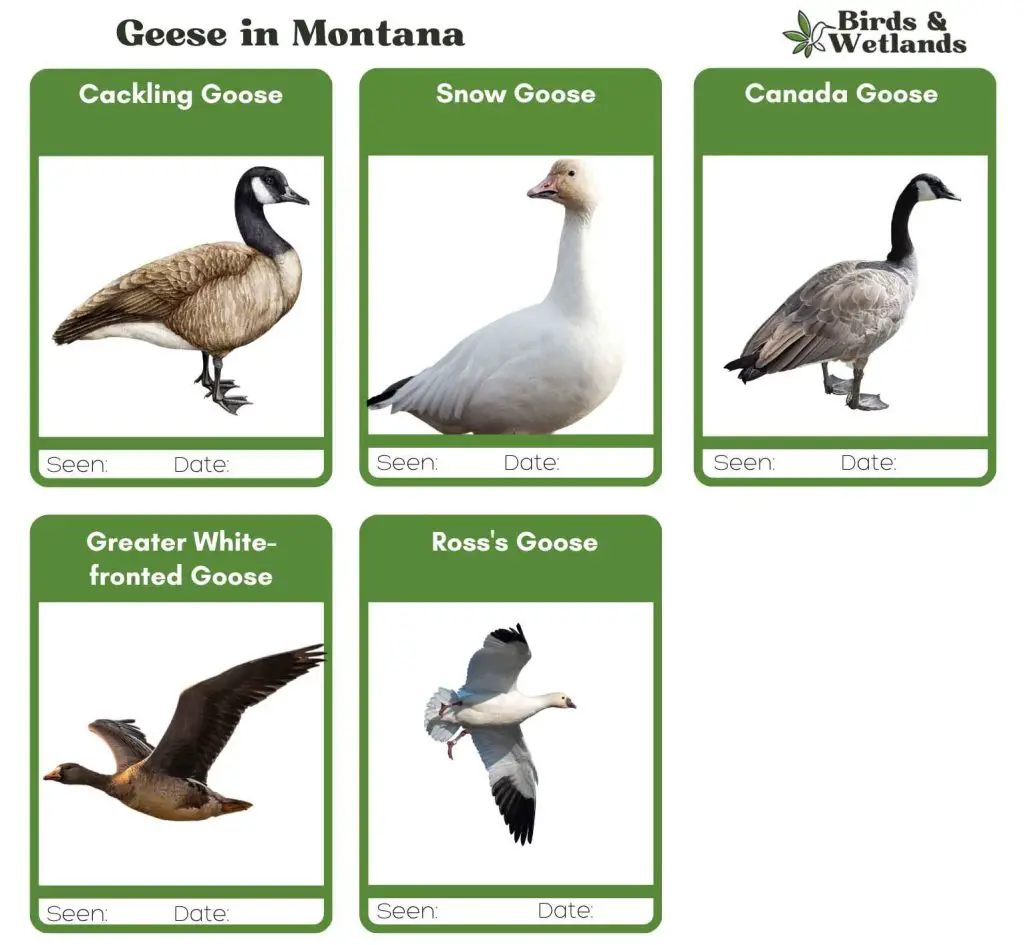
Canada Goose


Canada Goose Sound
Scientific Name: Branta canadensis
Length: 30 to 43 in
Wingspan: 50–73 in
Weight: 5.7–14.3 lb
The Canada Goose is a large, well-known species of waterfowl noted for its distinctive appearance, familiar “honk,” and migratory behavior.
Appearance: Both male and female Canada Geese have a similar appearance, featuring a black head and neck with distinctive white patches on the cheeks and chin. The body is primarily brown with a lighter, often white, underbelly.
Diet: Canada Geese primarily feed on plant matter, including grasses, aquatic vegetation, and grains. They can often be seen grazing in parks, lawns, and fields, as well as dabbling in water bodies.
Reproduction: Canada Geese typically nest on the ground near water bodies, often on islands or other isolated areas to avoid predators. The female lays a clutch of about 4 to 6 eggs, which she incubates alone for around a month.
Snow Goose

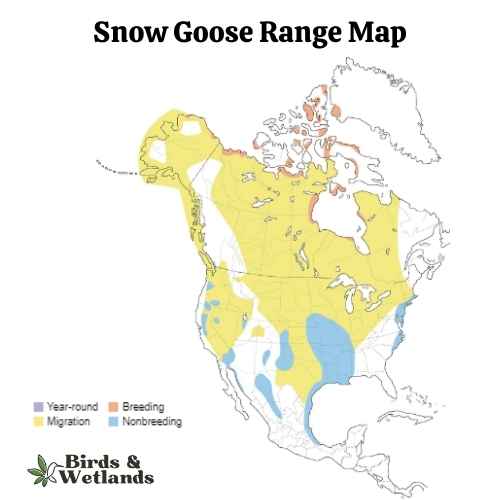
Snow Goose Sound
Scientific Name: Anser caerulescens
Length: 25 to 31 in
Wingspan: 53 to 65 in
Weight: 4.5 to 6.0
The Snow Goose is a large species of waterfowl known for its vibrant white plumage and significant migratory flights.
Appearance: True to their name, Snow Geese are predominantly white with black wingtips. They also have a pink bill, pink legs and feet. A color morph, known as the “Blue Goose,” displays a bluish-gray body with a white head, but is considered the same species.
Diet: Snow Geese primarily feed on plant matter, such as grasses, sedges, and small grains. They can often be seen in large flocks foraging in fields and marshes, and during migration and winter, they can cause considerable damage to agricultural fields due to their feeding habits.
Reproduction: Snow Geese typically nest on the tundra, near water bodies. The female builds the nest and lays a clutch of about 3 to 5 eggs, which she incubates alone for approximately three weeks. Once hatched, the goslings can feed themselves but stay with their parents for protection until they can fly.
Ross’s Goose
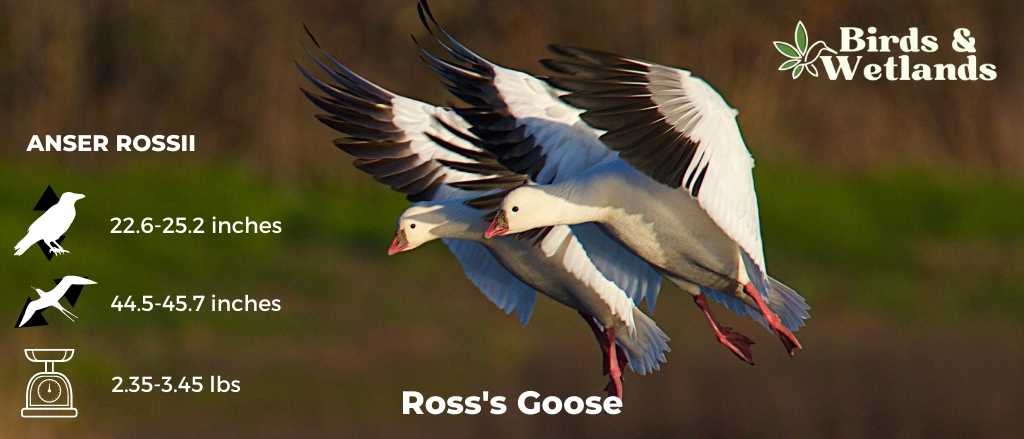
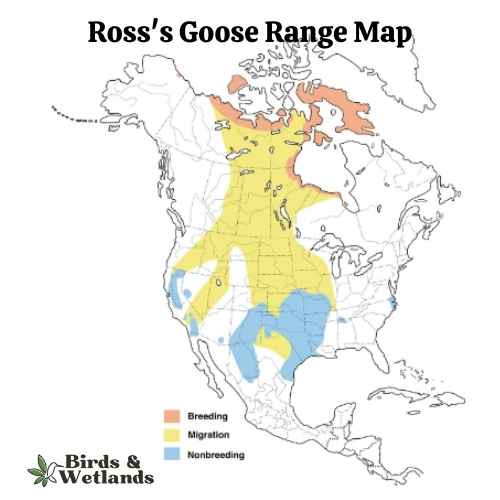
Listen
Scientific Name: Anser rossii
Length: 23.2-25.2
Wingspan: 44.5-45.7 in
Weight:42.3-55.3 oz
The Ross’s Goose is a small species of waterfowl often found in North America’s tundra and wetland habitats.
Appearance: Known for its compact size, the Ross’s Goose is mostly white with black wingtips. It features a short, stubby bill and a rounded head. One key identifying feature is the blueish gray base of its bill, which has a warty structure during the breeding season.
Diet: This goose feeds mainly on vegetation, including seeds, leaves, and roots of grasses and sedges. During winter and migration, they also consume grains and seeds from agricultural fields.
Reproduction: The Ross’s Goose nests on the ground, often in colonies. The female lays a clutch of 2 to 5 eggs which she incubates for around three weeks. The young geese, known as goslings, are precocial – they can walk, swim, and feed themselves shortly after hatching, although they stay with their parents until they learn to fly.
Cackling Goose
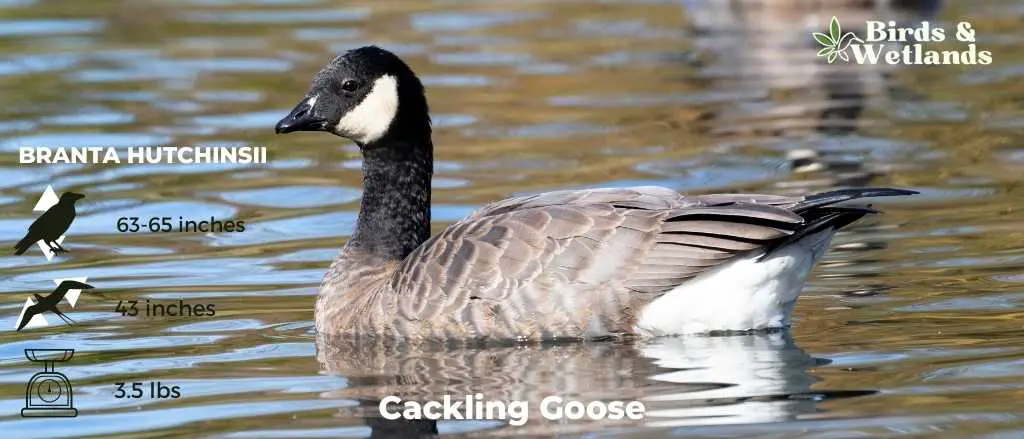
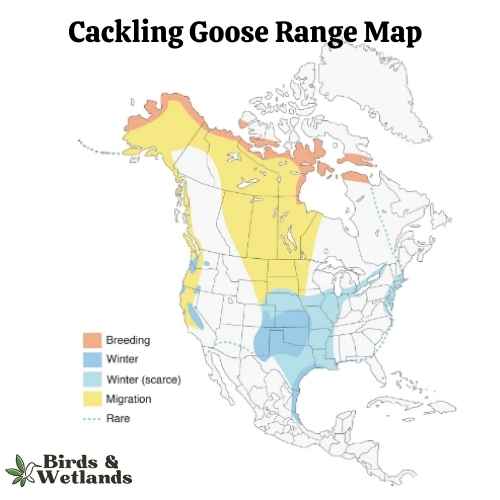
Listen
Scientific Name: Branta hutchinsii
Length: 24.8–25.6 in
Wingspan: 43-45.7 in
Weight:3.5 lbs
Cackling Geese are particularly known for their high-pitched, cackling calls, which is the source of their name. Despite their small size, these geese are renowned long-distance migrants, with some populations traveling thousands of miles between breeding and wintering grounds.
Appearance: With a similar color pattern to the larger Canada Goose, the Cackling Goose features a black head and neck, white chinstrap, light tan to cream chest, and brownish-grey body. One defining characteristic is its noticeably smaller size and stubbier neck compared to its larger counterparts.
Diet: Like many geese, the Cackling Goose’s diet mainly consists of plant matter. This includes grasses, seeds, and aquatic vegetation. They are often seen grazing on land or dabbling in shallow water.
Reproduction: Cackling Geese usually nest on the ground in elevated areas near water bodies, such as riverbanks or lakeshores. The female lays a clutch of 2 to 8 eggs and is responsible for incubation, while the male stands guard nearby. Incubation lasts for about a month.
Greater White-fronted Goose
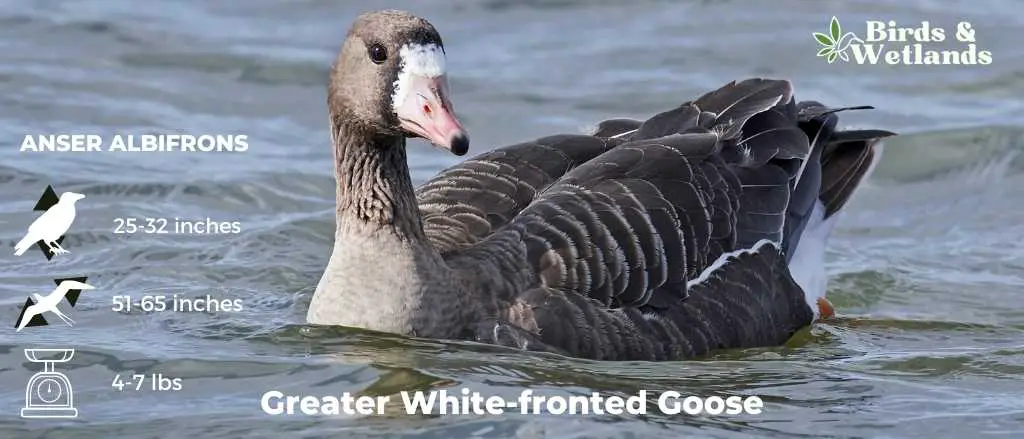

Listen
Scientific Name: Anser albifrons
Length: 25 to 31 in
Wingspan: 53 to 66 in
Weight: 3.3 to 6.6
The Greater White-fronted Goose is a medium to large waterfowl species, widely distributed across the Northern Hemisphere, particularly in North America.
Appearance: As the name suggests, these geese display a prominent white patch at the base of their bill. Their bodies are gray-brown, and their breasts are often marked with dark blotches. They possess a pinkish bill and orange legs and feet.
Diet: The Greater White-fronted Goose is a herbivore and feeds mainly on plant material. Its diet consists of grasses, sedges, grains, and berries. When wintering, these geese can often be found in agricultural fields, feasting on leftover grains and crops.
Reproduction: This species nests on the ground, often in areas with good visibility such as slopes or ridges. The female lays a clutch of 4 to 5 eggs, which she incubates for nearly a month. Once hatched, the young ones are taken care of by both parents until they are able to fly.
Are There Any Resident Flocks of Geese In Montana?
Canada geese are a common sight in Montana, with large populations residing in the state year-round. These birds are most often found near bodies of water, such as lakes and rivers, where they can feed on aquatic plants and insects.
Hunting Geese in Montana
Goose hunting is a popular sport in many parts of the country, and the state of Montana is no exception.
Although there are some restrictions in place, goose hunting is generally allowed throughout the state.
Hunters are required to obtain a special permit in order to hunt these birds, and there are also limits on the number of geese that can be taken each season.
Can You Shoot a Goose in Montana?
In the state of Montana, hunters are allowed to take migratory birds with longbows, recurve bows, compound bows, and arrows. They are also allowed to use shotguns that are no larger than 10 gauge and that cannot hold more than three shells. The shotgun must be fired from the shoulder. Additionally, hunters are allowed to use falconry to take migratory birds.
Montana also has daily bag and possession limits.
Where Can I Hunt Geese in Montana?
Montana is home to some of the best-hunting geese spots in the country.
The Yellowstone and Bighorn rivers are two of the most popular destinations for hunters looking to bag a big bird. Both rivers offer a variety of different habitats for geese, including open water, marshy areas, and grassy banks.
In addition, the riverbanks are lined with trees and shrubs that provide cover for the birds.
Is There a Goose Hunting Season in Montana?
Goose hunting in Montana usually takes place between the months of September to January.
Conclusion on Geese in Montana
If you’re ever in Montana, keep your eyes peeled for these large and impressive birds. They can be found all over the state, and they are always worth a look. Who knows, you might even get to see one of them take flight!


